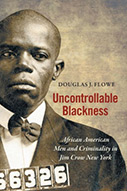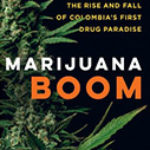Uncontrollable Blackness: African American Men And Criminality In Jim Crow New York

Author: Douglas Flowe
Publisher: Chapel Hill, NC: University of North Carolina Press, 2020. 332p.
Reviewer: Jennifer Fronc | November 2020
Douglas Flowe’s timely new book, Uncontrollable Blackness: African American Men and Criminality in Jim Crow New York, is a fascinating analysis of the construction of black criminality in the decades following emancipation, as well as an effort to historicize contemporary issues in policing, parole, and the criminal justice system at large. Deeply researched and compellingly written, Uncontrollable Blackness is a necessary contribution to the growing historiography of urban policing, and a critical intervention in criminology and criminal justice studies.
As historians of urban leisure have done for the concept of “vice,” Flowe interrogates the concept of “crime,” reminding readers that criminal law itself “can communicate the preferences of dominant groups, and crime can symbolize resistance and protest for those disenfranchised” (15). Uncontrollable Blackness focuses on New York City for several important reasons: it was home to a large police force, extensive prison system, and network of Progressive reformers, all of which Flowe interprets as “criminogenic” for the African American migrants and Afro-Caribbean immigrants to the city in the late 19th and early 20th centuries, turning the sociological concept on its head. Instead, Uncontrollable Blackness demonstrates that black men were “surrounded…by hazards to their health, happiness, mobility, and lives,” turning New York City into “a harsh theater of injustice that seized them in cycles of struggle and, sometimes, defiance,” where “the simple act of savoring the freedom to occupy public space could mean losing one’s life” (36). In the introduction, Flowe elaborates on a concept he terms “the crucible of black criminality.” By acknowledging the power that American chattel slavery exerted, and continues to exert, on “race relations, mechanisms of protest, and legal discourse, ” Flowe’s analysis demonstrates that black men’s “lawlessness” is better understood as behavior that fulfilled “entrenched human needs and aspirations” (17). For example, Flowe’s research reveals that “most men ground out a living through legitimate labor, but a significant subsection found it difficult, or impossible, to subsist or thrive with inconsistent work and low pay,” which spurred them to “actions others deemed unlawful” (8). Similarly, illicit activities and violence are responses to “endless threats” to black men’s “bodies and masculine identities,” or efforts to “defend their dignity in a society that wholly denied it” (15, 16). In addition, the crucible of black criminality forged the ways in which white New Yorkers understood the presence of black people in the city; the police; and the police’s role in mediating race relations and public space. The fact that police were unwilling to stop or investigate “property or violent crimes against blacks” revealed their “blatant indifference to the safety of black residents, which reinforced the distrust African Americans held for law enforcement” (53). Without equal access to jobs, housing, city streets, or public space, New York City’s poor black residents “remained under the same threats that characterized their lives since the end of slavery” (36). Life was no crystal stair, to paraphrase poet Langston Hughes.
Each chapter of Uncontrollable Blackness explores a facet of the crucible of black criminality, and is anchored by an individual’s story, making for an engaging and readable text. For example, Chapter 1 opens with the case of Jeremiah “Lamplighter” Dunn, who shot and killed a white man in self defense in 1900. Flowe uses Dunn’s story to illuminate how “men like Dunn sought equal access to public urban space, and their claims on manhood depended upon it, but white men fought to hem them in” (28). Furthermore, “with the state apparatus of the police on the side of whites, black men were harassed, assaulted, and killed with impunity” (28). Much like his re-evaluation of public space and city streets in the first chapter, Flowe’s second chapter analyzes commercial leisure spaces, saloons in particular, which constituted another public sphere delimited as white; even as Jewish and Italian immigrants were welcomed into these spaces, black men and women were still excluded (64). Although New York State had laws against racial segregation in public accommodations, Flowe found that the “courts failed to uphold the mandate in legal claims,” effectively rendering them useless (59). The importance of black saloons to black communities becomes clear within this context; black-owned and -frequented saloons allowed black patrons “to free themselves from the urban crucible on a nightly basis” (60). Moreover, saloons were “sites of potential power” for black men, as within the community, black-owned saloons represented collective success.
Uncontrollable Blackness is also an important work of gender history; throughout, Flowe “zooms in on the experiences of men,” and explores how they “coped with a justice system bent against them” (15). Chapter Three opens on the trial of Roosevelt Sharp, a black man accused of trafficking white women, and examines how the justice system saw behavior like Sharp’s as “invert[ing] centuries worth of custom, economic deprivation, and racial and sexual violence simply by taking command of white women’s bodies” (122). Flowe notes that sex workers themselves chose to immerse themselves in a racially-diverse world, which was inconvenient for the Progressives’ reformers like Maude Miner trying to save them (101). Black women were left out of reformers’ fictive narrative of the traffic in women altogether, as their focus on “involuntary sexual servitude” served to redirect public attention “away from the role of urban class inequality in driving women to sex work, and angled it toward the danger autonomous and pleasure-seeking women attracted to themselves” (95). Chapter Four analyzes “the politics of black intimacy,” and considers how marriage and patriarchy could be criminogenic for black men and women, as “discord over finances, gender roles, unfaithfulness, and sex increased the chances women would experience desertion and betrayal, domestic violence, or outright homicide” (128). Chapter 5 also examines black families, this time in the context of parole and its redounding impact on the families and communities left behind. Flowe’s analysis reveals that parole was not freedom, as those on parole found themselves in programs that “mimicked the impact of enslavement on African American men and their families” (159). Notably, this chapter locates the phenomenon of “discriminatory arrests and trials, wrongful accusations, and long prison sentences” in a much earlier time period than have other historians, like Elizabeth Hinton and Max Felker-Kantor, who begin their analysis in the post-World War II period (156).
Douglas Flowe has reexamined the concepts of “social pathology” and “criminogenic needs,” and produced a rich exploration of crimes of survival, attempts to claim space in the city, and the unequal role and rights of “manhood” for black and white men. For professors teaching courses in urban and gender studies, Uncontrollable Blackness would be a good companion text to works by historians Cheryl Hicks, LaShawn Harris, and Kali Gross. For those teaching in policing and criminology, Flowe’s work enters an interesting conversation with historian Jeffrey Adler’s work on husband killing and domestic violence in Chicago. All in all, Uncontrollable Blackness is exactly the kind of historical study our current moment requires.
Jennifer Fronc, Professor of History, University of Massachusetts-Amherst


